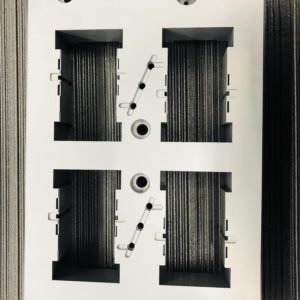
The plastic injection molding industry is growing at a healthy rate, there’s no doubt about that.
With expected industry growth of over 5% through 2020, revenues are projected to eclipse $162 billion worldwide, and North America continues to hold the lion’s share of the market, for now.
The industry has seen a considerable amount of revenue growth, job creation, and innovation – as well as competition.
Companies in the plastic injection molding space have already felt the pressure to stay up-to-date with technology improvements in order to remain competitive, especially since overseas production is rapidly increasing (and most organizations in North America can’t compete with those labor rates).
The companies who are seeing the upside of this growing industry are those who can produce quickly, accurately, efficiently, and affordable.
Those who can’t perform at this level will be outperformed, plain and simple.
ACS has worked alongside companies in the plastic injection molding industry to help create efficiencies in their operation so they can stay competitive within this growing sector.
PVD coatings are paramount to creating long-lasting, accurate, and efficient molding and components.
HOW PVD COATING MAKES PLASTIC INJECTION MOLDS MORE DURABLE
PVD coating is a deposit of an extremely thin, yet extremely hard layer of metal based particles over the surface and cavities of your mold. Typically, the metals are applied in the presence of a reactive gas like nitrogen (N2) or a carbon containing gas like acetylene to form the ceramic like alloys of nitrides, carbides, and carbo-nitrides.
It’s like coating your mold in a suit of ceramic armor, helping it perform more consistently for a longer period of time.
By coating your mold and its components with a thin film of a hard alloy like Titanium Nitride (TiN), Titanium Carbo-Nitride (TiCN), or Chrome Nitride (CrN), you will significantly increase its resistance against abrasive glass-filled resins, as well as hot-gas corrosion from plastics like PVC.
This layer of metals is ultra-thin – we’re talking 2 – 3 micron range – so your mold can be finished in its final size before the coating is applied. And due to this thinness, the coating will not affect the dimensions of the mold or the resulting parts. Also, these coatings replicate the surface finish, so if you have polished mold surfaces, they will be preserved after coating.
A PVD coating can also be stripped away and recoated before the mold ever becomes eroded, eliminating the time and cost of replacing the original mold.
At the end of the day, a PVD coating allows you to get more runs out of a single mold, and creates an opportunity to continuously reuse a coated mold which will reduce costs for you and your customers.
PVD COATING ACTS AS A LUBRICANT ON PLASTIC INJECTION MOLDS
PVD coatings will reduce friction on the components and in the cavities of your plastic injection mold.
This helps the process in a number of ways.
First, this lubricity helps the molten plastic flow through the mold much easier and faster, allowing for more uniform filling.
The molten plastic glides through the mold with less resistance and the pressure from the barrel continues to exert force on the plastic throughout the entire mold cavity.
This allows the plastic to flow deeper into complex crevices, reducing sink marking and giving the final mold product a much higher – and more accurate – degree of definition.
Not only does the material flow into and through the mold with less resistance, the finished molded product can be ejected much easier as well.
The lubricity added by a PVD coating helps reduce sticking and corrosion on ejection components (pins, plates, housing), which also speeds up the ejection process.
This creates a faster cycle time because of the expedited ejection, as well as fewer damaged or incorrectly made parts.
Not to mention, a PVD coating can oftentimes even help eliminate the need for sprayed release agents, saving costs on material and labor.
PVD coatings also allow molds to be cleaned much easier, meaning your teams produce more parts and experience less cleaning, maintenance, and downtime.
At the end of the day, the inherent lubricity of PVD coatings help injection molds by allowing the plastic to flow into the mold easier, and allowing the ejection mechanism to do their work with less resistance.
PVD COATINGS CAN GIVE AN EDGE AGAINST THE COMPETITION
A PVD coating is an investment into your plastic injection molding operation that can markedly impact the bottom line.
We know that molds are expensive to manufacture. The application of the proper hard coating can extend the lifetime of your expensive mold assembly, thus eliminating machine downtime and mold rebuilding.
Applying PVD coatings to your molds will allow you to produce more products faster, with less downtime and with increased efficiency from your team and your machines.
It will allow you to create highly detailed finished products that experience less friction, disruption, and disfigurement when ejected.
Offering a plastic injection mold with a PVD coating will also help to distinguish you from your competitors because you can offer the much-desired benefits of increased speed, increased uptime, and consistent production.
GETTING STARTED WITH ACS IS A SMALL STEP WITH HUGE POTENTIAL
If you’re interested in exploring the opportunities of PVD coating your plastic injection molds, get in touch with Don Titus, III (Coating Specialist & COO) at Advanced Coating Services.
By setting up an engineering consultation with Don , you’ll be able to discuss the specific needs of your company and projects, as well as get detailed insight on the types of coatings available and which solutions will best fit for your project.

[…] applying advanced coatings6 can create smoother surfaces or add specific features like anti-fogging or anti-scratch […]